![]()
![]()
![]()
Use LEFT and RIGHT arrow keys to navigate between flashcards;
Use UP and DOWN arrow keys to flip the card;
H to show hint;
A reads text to speech;
21 Cards in this Set
- Front
- Back
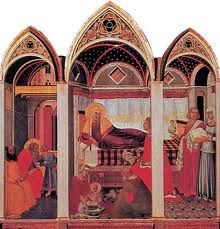
14-14: Birth of a Virgin
|
Name: Birth of a Virgin
Date: 1342 Period/Style: Late Medieval Architect: N/A Patron: Saint Savenus Original Location: Sienna, Italy Materials: tempura on wood Technique: painted wooden architectural members dividing he altarpiece Function: made for the Siena Cathedral Context: revived the pictorial illusionism of ancient Roman murals Descriptive Terms: a triptych Meaning: setting for this holy subject represented a marked step in advance of worldly realism |
|
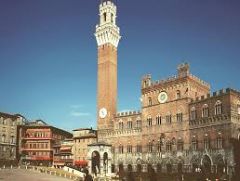
14-15 Palazzo Pubblico
|
Name: Palazzo Pubblico
Date: 1288-1309 Period/Style: Late Medieval Architect: unknown Patron: unknown Original Location: Siena, Italy Materials: concrete Technique: most important fresco style Function: city hall Context: a secular center of the community and political rival of Florence Descriptive Terms: has a concave facade and a gigantic tower visible for miles around Meaning: served as both a defensive lookout over the country side and a symbol of the city-state 's power |
|
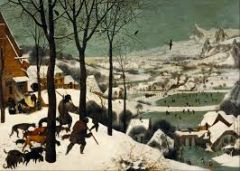
23-22 Hunters in the Snow
|
Name: Hunters in the Snow
Date: 1565 Period/Style: High Renaissance Architect: Pieter Bruegel Patron: Kunsthistorisches Museum Original Location: Vienna, Italy Materials: oil on wood Technique: linear Function: description of hunters' failure Context: illustrates diff seasons Descriptive Terms: draws the viewers diagonally deep into the landscape Meaning: uses mastery line, shape, and composition |
|
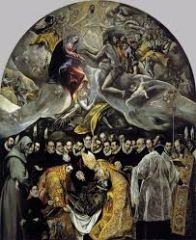
23-25 Burial of Count Orgaz
|
Name: Burial of Count Orgaz
Date: 15896 Period/Style: High Renaissance Architect: El Greco Patron:unknown Original Location: Santo Tome, Toledo Materials: oil on canvas Technique: blend of Byzantine style and Italian Mannerism Function: fervor of Spanish Catholicism Context: naturally appealed to Spanish peity Descriptive Terms: used intense emotional content Meaning: use of light foreshadowed Baroque style |
|
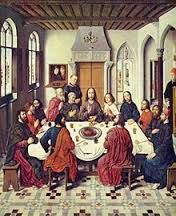
20-11 Last Supper
|
Name: Last Supper
Date: 1464-1468 Period/Style: Early Renaissance Architect: Dirk Bouts Patron: unkown Original Location: Belgium Materials: oil on wood Technique: linear perpective Function: employ Renaissance Context: one of the earliest works in Northern European art Descriptive Terms: includes four servants in Flemish attire Meaning: these servants were the unknown patrons |
|
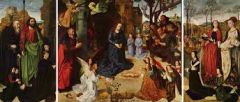
20-12 Portinari Altarpiece
|
Name: Portinari Altarpiece
Date: 1476 Period/Style: Early Renaissance Architect: Hugo Van Der Goes Patron: Tommaso Portinari Original Location: Florence, Italy Materials: tempura and oil on wood Technique: contains a lot of symbolism Function: a painting for the patron Context: realistic details and brilliant portrayal of human character Descriptive Terms: the subject in the center panel is the Adoration of the Shepards Meaning: portrayal of events in bible |
|
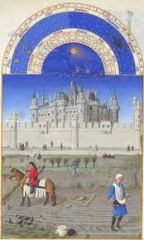
20-16 October from Les Tres Riches Heures du Duc de Berry
|
Name: October
Date: 1413-1416 Period/Style: Early Renaissance Architect: Limbourg Brothers Patron: unknown Original Location: Chantilly Materials: colors and ink on vellum Technique: illusionistic Function: represented the 12 monthsin terms of the associated seasonal tanks Context: depicted zodiac signs Descriptive Terms: has architectual details and convincing depiction of cast shadows Meaning: most famous in history of manuscript illumination |
|
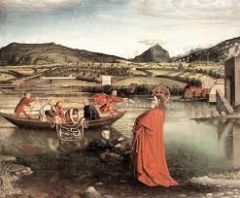
20-18 Miraculous Draught of Fish
|
Name: Miraculous Draught of Fish
Date: 1444 Period/Style: Early Renaissance Architect: Konrad Witz Patron: unknown Original Location: Geneva, Switzerland Materials: oil on wood Technique: contains water effects Function: depicts a specific locale Context: noteworthy for the painter's skill in rendering water skills Descriptive Terms: sets biblical story on Lake Geneva Meaning: series of Adoration of the Magi |
|

21-1 Primavera
|
Name: Primavera
Date: 1482 Period/Style: Italian Renaissance Architect: Sandro Botticelli Patron: Cosimo de Medici Original Location: Florence, Italy Materials: tempura on wood Technique: humanism Function: depict Venus and Cupid Context: a bunch of mythological creatures are conveyed here each by meaning for the patron Descriptive Terms: bright colors for the focused figures while the background is dark Meaning: for the Medici family who loved Greco-Roman mythology |
|
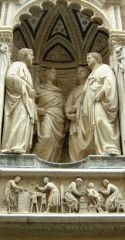
21-4 Four Crowned Saints
|
Name: Four Crowned Saints
Date: 1410-1416 Period/Style: Italian Renaissance Architect: Nanni Di Blanco Patron: Emperor Diocletian Original Location: Florence, Italy Materials: marble Technique: spatial composition Function: stands in niche for a fill in Context: used to fill in empty space on a monumental scale Descriptive Terms: liberate statuary from its architectural setting Meaning: represents the four martyred patrons |
|
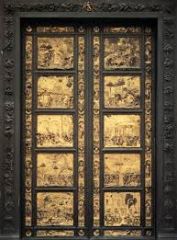
21-9 east doors of the Gates of Paradise
|
Name: east doors of the Gates of Paradise
Date: 1425- 1452 Period/Style: Italian Renaissance Architect: Lorenzo Ghiberti Patron: cathedral officials Original Location: Florence, Italy Materials: gilded bronze Technique: quatrefoil drames Function: for biblical scenes in the cathedral Context: recalls painting techniques in their depiction of space and treatment of the narrative Descriptive Terms: perspective illusion Meaning: depicts an episode from the Old Testament |
|
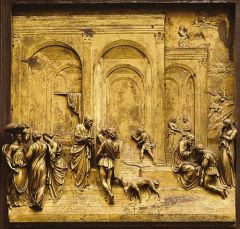
21-11 perspective diagram of Isaac and His Sons
|
Name: perspective diagram of Isaac and His Sons
Date: 1425-1452 Period/Style: Italian Renaissance Architect: Lorenzo Ghiberti Patron: unknown Original Location: Florence, Italy Materials: gilded bronze |
|
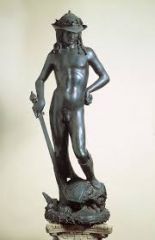
21-12 David
|
• Donatello, David, ca. 1440-1460
o Materials/medium: o Size/scale: 5’2 (life-size) o Subject: David symbol of Florentine Republic o Stylistic features: free-standing nude statue since antiquity o Function & significance: Nudity used to portray Biblical hero, David. Hat symbolizes Renaissance person. |
|
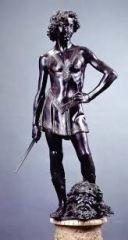
21-13 David
|
• Andrea del Verrocchio, David, ca. 1465-1470
o Materials/medium: Bronze o Size/scale: 4’1 o Subject: brash young man, dressed in leather outfit o Stylistic features: Narrative realism o Function & significance: Sponsored by Medici family |
|
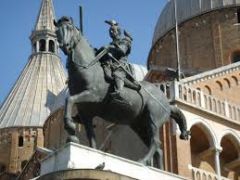
21-16 Gattamelata
|
• Donatello, Gattamelata (equestrian statue of Erasmo da Narni), Piazza del Santo, Padua, Italy, ca. 1445-1453
o Materials/medium: Bronze o Size/scale: 12’2 o Subject: Venetian general on equestrian statues of ancient Roman emperors o Stylistic features: portrait o Function & significance: convey irresistible strength |
|
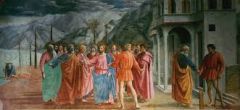
21-19 Tribute Money
|
• Masaccio, Tribute Money, Brancacci chapel, Santa Maria del Carmine, Florence, Italy, ca. 1424-1427
o Medium/materials: fresco o Size/scale: 8’4 1/8 19’7 1/8 o Subject: Figures light coming from a source outside the picture o Stylistic features: simple grandeur o Function & significance: greater phsycological and physical credibility |
|
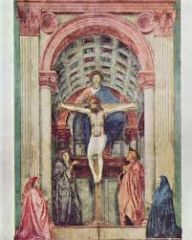
21-21 Holy Trinity
|
• Masaccio, Holy Trinity, Santa Maria Novella, Florence, Italy, ca. 1424-1427
o Medium/materials: fresco o Size/scale: 21’10 5/8 10’4 3/4 o Subject: Looks 3D o Stylistic features: linear perspective o Function & significance: Application of mathematics to depiction of space |
|

21-22 Annunciation
|
• Fra Angelico, Annunciation, Can Marco, Florence, Italy, ca. 1438-1447
o Medium/materials: fresco o Size/scale: 7’1 10’6 o Subject: Top of stairs, in monastery o Stylistic features: devotional image o Function & significance: Faces more rounded and realistic. |
|
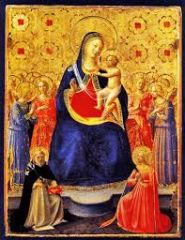
21-24 Madonna and Child
|
• Fra Filippo Lippi, Madonna and Child with Angels, ca. 1460-1465
o Medium/materials: tempera on wood o Size/scale: 2’11 ½ x 2’1 o Subject: Monk guilty of many misdemeanors o Stylistic features: humanization o Function & significance: represented Virgin and Christ Child in world manner |
|

21-25 Resurrection
|
• Piero della Francesca, Resurrection, Palazzo Communale, Borgo San Sepolcro, Italy, ca. 1463-1465
o Medium/materials: fresco o Size/scale: 7’ x 6’ o Subject: Christ miraculously rises from tomb o Stylistic features: head-on view o Function & significance: Viewers see framing portrico |
|
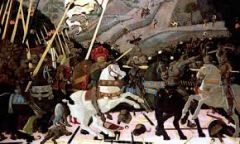
21-28 Battle of Romano
|
• Paolo Uccello, Battle of San Romano, ca. 1435 or ca. 1455
o Medium/materials: tempera on wood o Size/scale: 6’ by 5’ o Subject: Ceremonial than realistic battle o Stylistic features: Forshorening o Function & significance: Perspective |

